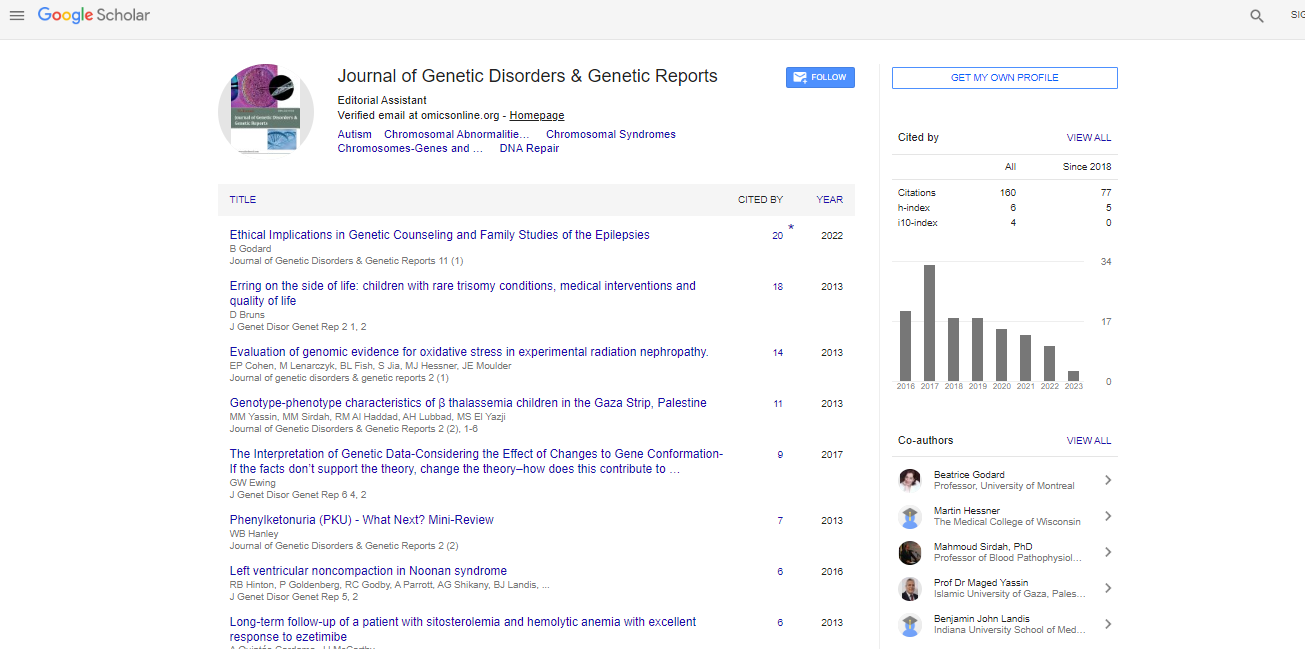Case Report, J Genet Disor Genet Rep Vol: 2 Issue: 2
Hereditary Thrombocytosis in 3 Kuwaiti Siblings with Homozygous MPL Pro106Leu Mutation and Abnormal Platelet Aggregation
| Preethi Reddy Marri 1, Salman Kirmani 3 and Vilmarie Rodriguez1,2* | |
| 1Division of Pediatric Hematology and Oncology, Mayo Clinic, Rochester, Minnesota, USA | |
| 1Division of Hematology, Mayo Clinic, Rochester, Minnesota, USA | |
| 3Department of Medical Genetics, Mayo Clinic, Rochester, Minnesota, USA | |
| Corresponding author : Dr. Vilmarie Rodriguez, MD Division of Pediatric Hematology and Oncology, Mayo Clinic, 200 First St SW, Rochester, MN 55905, USA E-mail: Rodriguez.Vilmarie@mayo.edu |
|
| Received: June 27, 2013 Accepted: October 07, 2013 Published: October 14, 2013 | |
| Citation: Marri PR, Kirmani S, Rodriguez V (2013) Hereditary Thrombocytosis in 3 Kuwaiti Siblings with Homozygous MPL Pro106Leu Mutation and Abnormal Platelet Aggregation. J Genet Disor Genet Rep 2:2. doi:10.4172/2327-5790.1000105 |
Abstract
Hereditary Thrombocytosis in 3 Kuwaiti Siblings with Homozygous MPL Pro106Leu Mutation and Abnormal Platelet Aggregation
Thrombocytosis is defined as a platelet count of more than 450 × 109/L in adults and children. Primary thrombocytosis is characterized by an increase in platelets due to alterations targeting the hematopoietic cell and can be subdivided as hereditary (rare) and sporadic disease as in myeloproliferative and myelodysplastic conditions.
Keywords: Bleeding; Hereditary thrombocytosis; MPL; Platelet aggregation; THPO
Keywords |
|
| Bleeding; Hereditary thrombocytosis; MPL; Platelet aggregation; THPO | |
Introduction |
|
| Thrombocytosis is defined as a platelet count of more than 450 × 109/L in adults and children [1,2]. Primary thrombocytosis is characterized by an increase in platelets due to alterations targeting the hematopoietic cell and can be subdivided as hereditary (rare) and sporadic disease as in myeloproliferative and myelodysplastic conditions [3]. | |
| Secondary or reactive thrombocytosis is more frequent and characterized by an increase in platelet count due to an external cause, such as chronic inflammation, malignancy, iron deficiency, or postsplenectomy rebound. It rarely causes complications, and management is usually directed at treating the underlying disease [1,4,5]. | |
| Apart from 4 activating mutations in the thrombopoietin gene (THPO), 3 mutations in the thrombopoietin receptor (MPL) have been described in hereditary thrombocytosis. MPL and thrombopoietin are the most important determinants of platelet production. | |
| Herein we describe 3 siblings with thrombocytosis, homozygous for MPL P106L mutations, presenting with bleeding complications and evidence of in vitro platelet dysfunction | |
Case Report |
|
| A 14-year-old boy from Kuwait had a history of persistent thrombocytosis, epistaxis, and prolonged bleeding after minor cuts and procedures (dental extractions, intestinal polypectomies). Evaluation of bone marrow during infancy was reported to show megakaryocytic hyperplasia with random clustering of platelets. Cytogenetic studies on bone marrow were negative for BCR-ABL gene fusion. He required platelet transfusions for dental extraction and subsequently underwent platelet pheresis with recombinant factor VIIa before invasive surgical procedures to prevent bleeding complications. He was evaluated in Europe for ongoing symptoms before coming to the United States. | |
| The patient’s younger brothers, aged 10 and 2 years, had thrombocytosis (898 and 740 × 109/L, respectively). The 10-yearold was reported also to have epistaxis. The parents are first cousins and also have a 12-year-old son and 9-year-old daughter who are reportedly healthy, with normal platelet counts. | |
| Informed consent was obtained from the family to evaluate for clonal abnormalities. Peripheral blood was negative for in situ hybridization for myelodysplastic syndrome and BCR-ABL. Sequence analysis of exon 10 of the MPL gene was negative as was JAK2 V617F mutation testing. Further, DNA extracted from peripheral blood leukocytes was analyzed for the entire coding region of MPL (Prevention Genetics, Marshfield, Wisconsin), which revealed homozygosity for exon 3, p.Pro106Leu (c.317C>T) mutation in all 3 brothers (Figure 1). Both parents and the other brother and sister had normal platelet counts and were found to be heterozygous carriers. | |
| Figure 1: Whole exon sequencing with an MPL exon 3 sequence showing c.317C>T. | |
| Comprehensive bleeding diathesis evaluation was performed in the affected siblings (Table 1). Global platelet aggregation abnormalities in vitro were detected in all 3 affected brothers with high-dose adenosine diphosphate, arachidonate, low-dose collagen, and epinephrine. A 6-week trial of hydroxyurea in the 10-year-old resulted in minimal decline in platelet counts and persistence of in vitro platelet dysfunction. A desmopressin trial (0.3 mcg/kg with saline infused over 30 minutes) was performed on the 14-year-old in preparation for a dental procedure; most in vitro platelet aggregation abnormalities persisted. However, platelet function analyzer closure time results were corrected. Desmopressin infusion before the dental extraction resulted in good hemostasis. | |
| Table 1: Pertinent Findings on Bleeding Diathesis Evaluation in 3 Siblings. | |
| The 14-year-old subsequently underwent adenotonsillectomy for obstructive sleep apnea and was treated preoperatively with desmopressin. He had severe bleeding problems requiring intubation to protect the airway and balloon pressure application in addition to use of tranexamic acid. Despite these measures, oozing persisted at the surgical site, and platelet transfusions were administered. Platelet pheresis was performed for a few days with good hemostatic response. He was discharged in stable condition. No thrombotic events were noted. | |
| Treatment recommendations were 2-fold: for minor mucosal bleeding, desmopressin acetate nasal spray, 1.5 mg/mL, and for severe bleeding, single-donor platelet transfusion with platelet pheresis. He returned home, and annual follow-up was recommended. | |
Discussion |
|
| Hereditary thrombocythemia is a rare, chronic myeloproliferative disorder caused by molecular alterations in the thrombopoietin gene (THPO) or in the thrombopoietin receptor gene (MPL) [3]. Three germline mutations in MPL causing thrombocythemia have been described thus far: 1) p.Ser505Asn, associated with autosomal dominant inheritance thrombocythemia [6ΓΆΒ?Β?8]; 2) p.Lys39Asn, a functional polymorphism restricted to African Americans [9]; and 3) p.Pro106Leu, frequently found in patients from the Arabian Peninsula and associated with autosomal recessive inheritance [10]. Of the 3 mutations in MPL, p.Pro106Leu and p.Lys39Asn are likely variations affecting specific ethnic groups. The prevalence of p.Pro106Leu alleles among patients of Arab descent is reported to be 6%, likely attributable to the high rate of consanguinity [3]. | |
| Patients homozygous for MPL P106L exhibited marked thrombocythemia (>1,000×109/L), while heterozygotes displayed mild thrombocythemia or normal platelet counts, assuming autosomal recessive inheritance [10]. Of the intracellular, juxtamembranous, and extracellular components of MPL protein, it is known that this mutation can cause structural alterations in the extracellular domain leading to constitutional activation, preventing ligand binding and recognition by antibodies, thus contributing to relative increase in thrombopoietin levels through its defective clearance. p.Pro106Leu mutation could also cause defective processing of the MPL protein, leading to decreased expression on cell surface and constitutive activation of mutated protein causing thrombocytosis [10]. Thrombotic complications are more frequent than bleeding complications in essential thrombocythemia. Aspirin therapy is usually recommended in adult patients with microcirculatory symptoms, a recent major vascular event, or clinical or laboratory evidence of coronary artery disease [11]. Platelet-lowering agents such as hydroxyurea or anagrelide are recommended for extreme thrombocytosis (>1500 × 109/L). | |
| Bleeding complications occurred in 5% to 30% of adult patients [12-14] with essential thrombocythemia. A retrospective analysis of 565 patients with essential thrombocythemia found splenomegaly, platelet count higher than 1,000 × 109/L, and leukocyte count higher than 11 × 109/L were risk factors for hemorrhage [14]. With all 3 factors, the cumulative risk for bleeding was 45.8% at 10 years (P<0.001). The increased bleeding observed was thought to be caused by acquired von Willebrand disease, platelet abnormalities, platelet activation by leukocytosis, aspirin use, and potential portal hypertension in a subgroup of patients with gastrointestinal tract bleeding from esophageal varices. | |
| To our knowledge, this is the first report describing platelet dysfunction and bleeding complications in association with MPL P106L mutations. The pathophysiologic abnormality leading to bleeding complications described here is likely secondary to constant platelet activation and degranulation. However, electron microscopy of the platelets to visualize platelet granules may suggest whether abnormal or depleted intraplatelet granules are the reason for bleeding manifestations. All siblings had mildly decreased von Willebrand antigen and activity level, which has been described in patients with essential thrombocythemia as well [15,16]. However, the multimer distribution appeared to be normal in all siblings. | |
| Treatment strategies are mostly conservative, including observation. Patients with no splenic enlargement may not require treatment. Thrombotic risks appeared to be lower compared to nonhereditary thrombocytosis. Heterozygous MPL P106L mutation carriers were not found to have thrombotic accidents [10]. Agents like hydroxyurea and anagrelide have been used in some patients with variable responses. In our index family, the second sibling had a trial of hydroxyurea. Despite increasing the dose to 20 mg/kg, platelet counts decreased minimally, and in vitro platelet function abnormalities persisted (data not shown). Aspirin use is contraindicated in patients with bleeding history. However, desmopressin may be used in special situations before surgery if the patient has had bleeding complications. Platelet pheresis may be used in acute life-threatening situations. Treatment recommendations should be individualized on the basis of the patient’s history of bleeding or thrombosis and response to therapy. | |
Conclusion |
|
| Our cases highlight the importance of considering MPL mutations in patients of Arab descent presenting with thrombocytosis, bleeding symptoms, and abnormal platelet aggregation, given the high rate of consanguinity and a carrier rate of 6% for the P106L mutation. Once a mutation is identified, genetic counseling plays an important role. Patients homozygous for this mutation appear to have a predisposition for bleeding diathesis rather than thrombotic events. | |
Acknowledgments |
|
| Conflict of interest statement: The authors declare no competing financial interests. | |
References |
|
|
|
 Spanish
Spanish  Chinese
Chinese  Russian
Russian  German
German  French
French  Japanese
Japanese  Portuguese
Portuguese  Hindi
Hindi 



